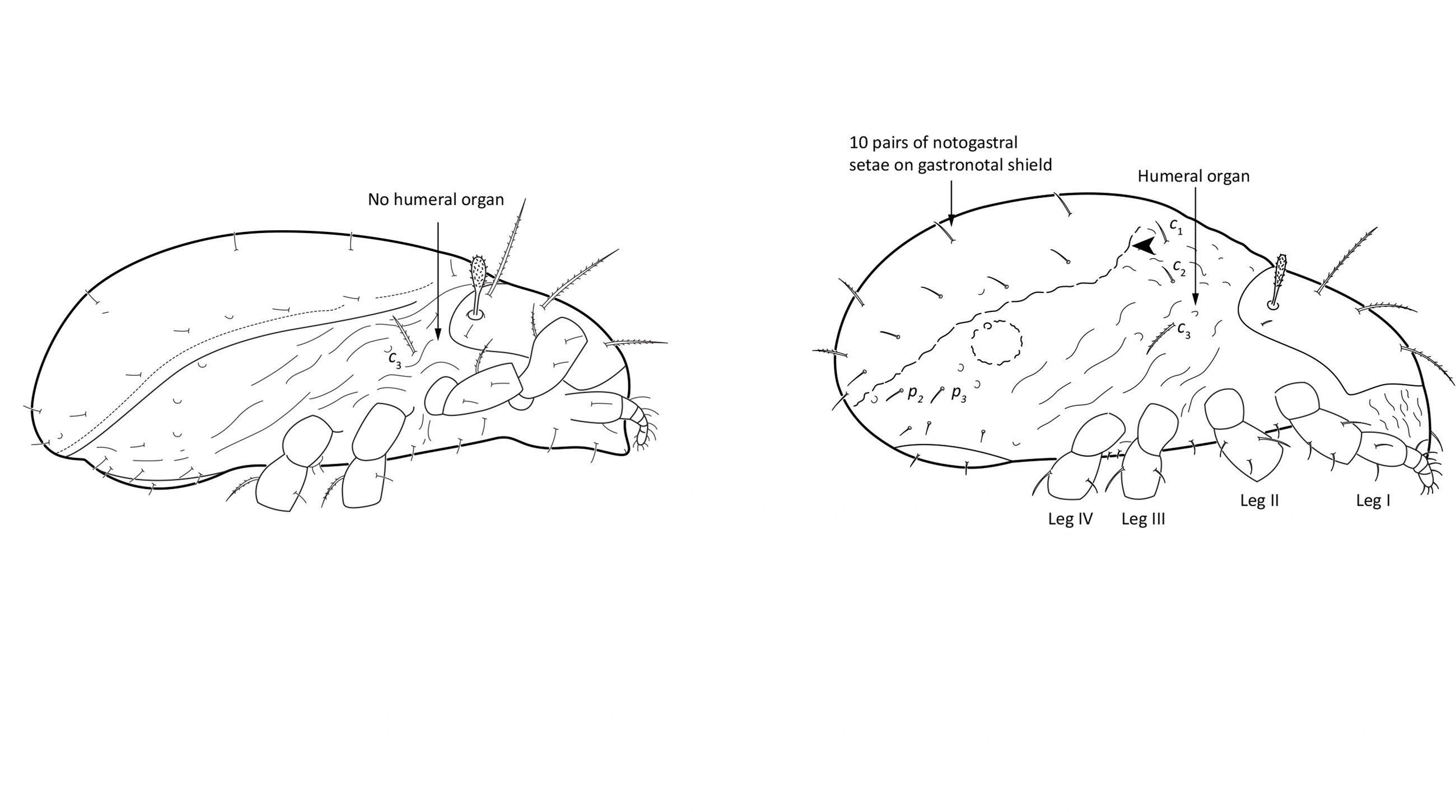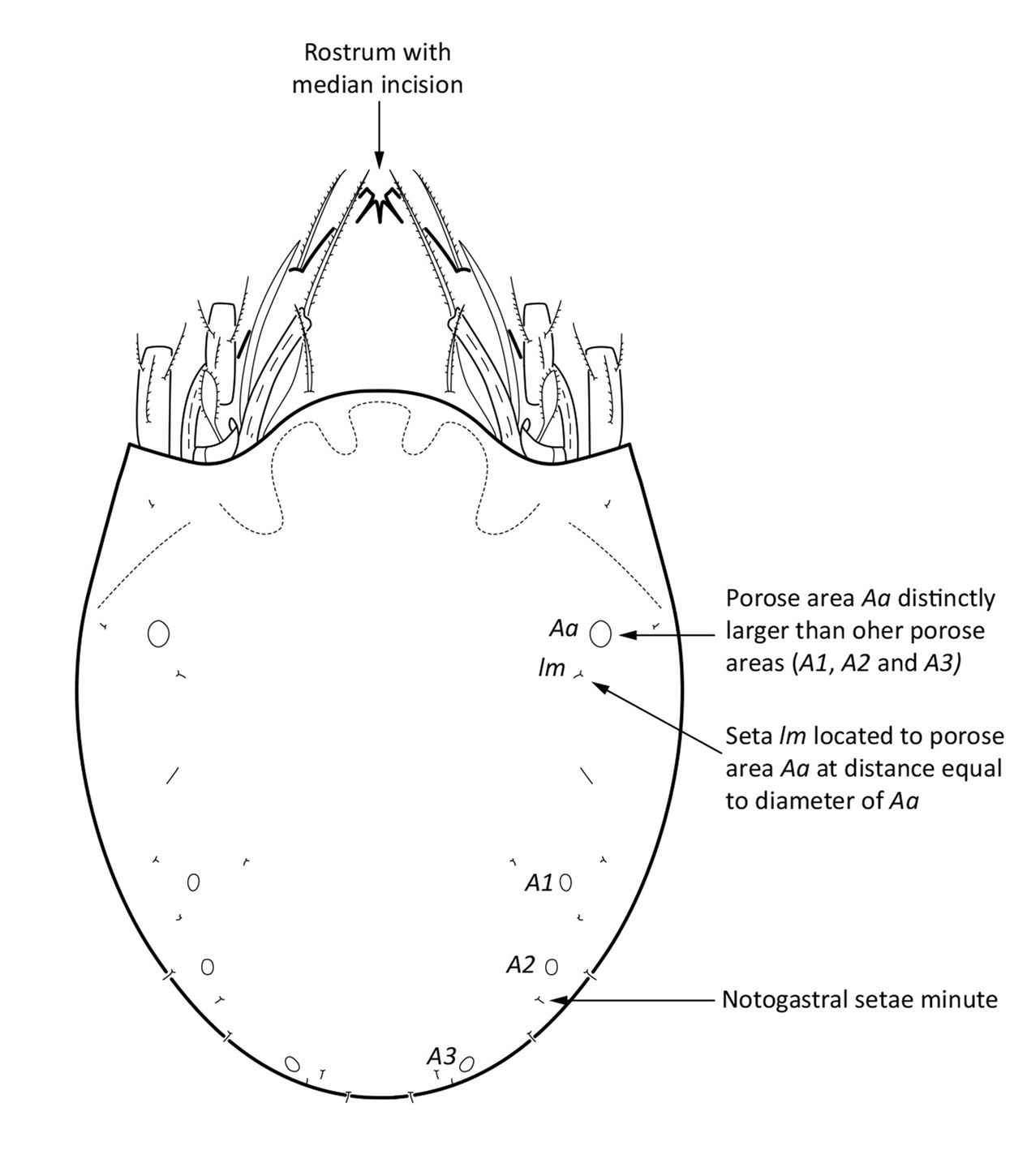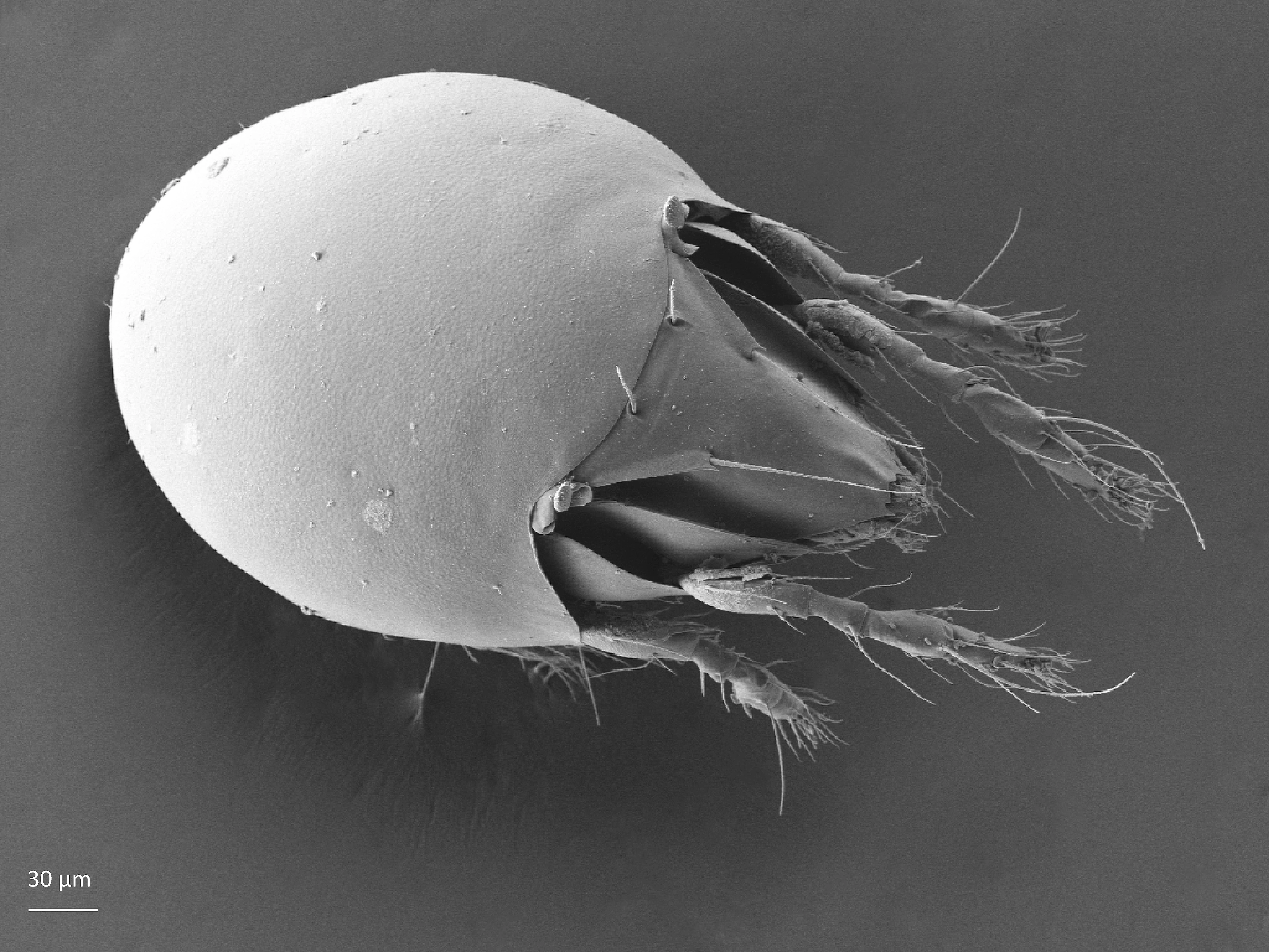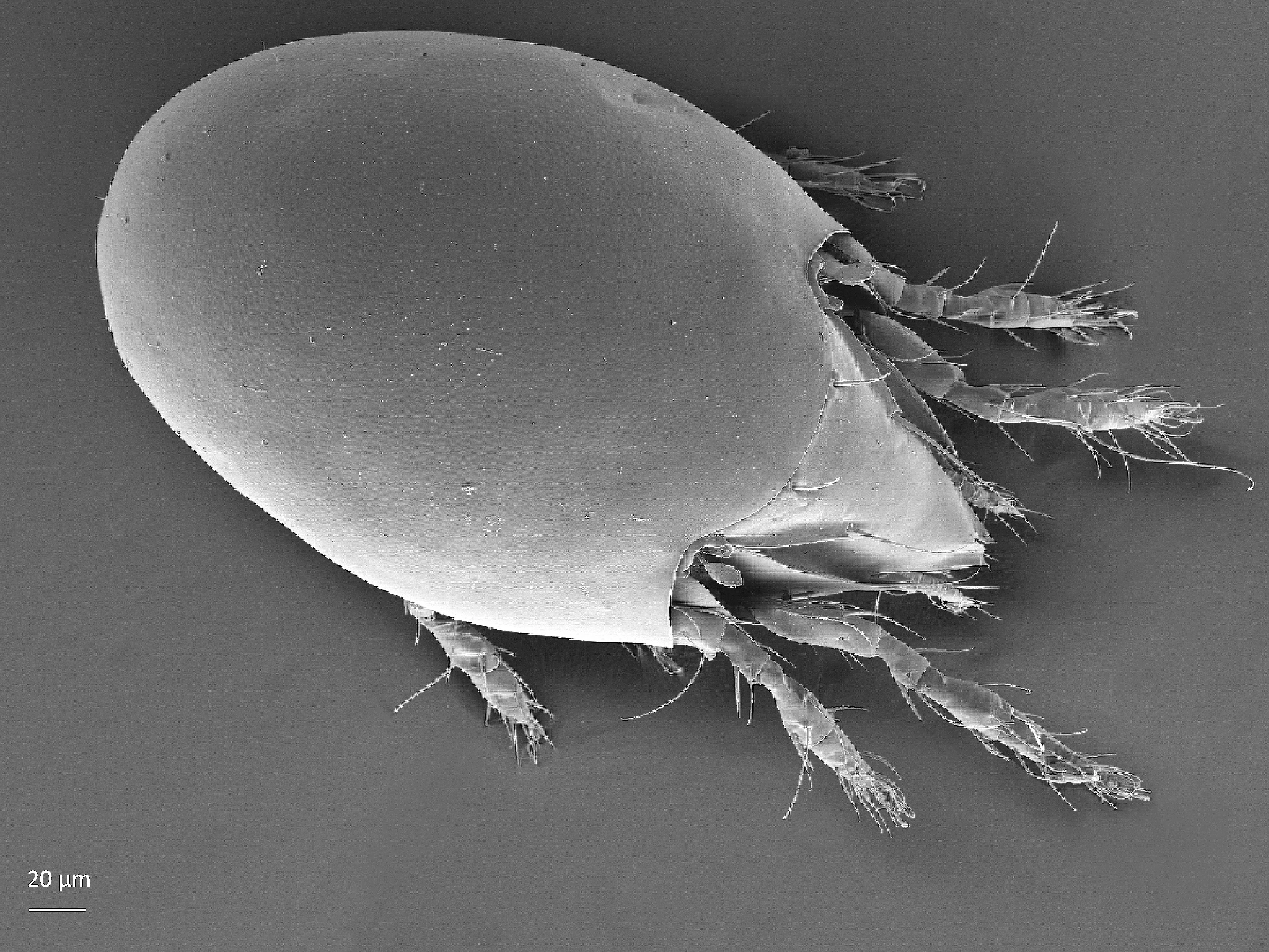Chamobates pusillus
Chamobates pusillus is found in forest soils, heaths and bogs. In forests and in bogs in Western Norway it co-occurred with Chamobates borealis, but was less abundant. It is active under the snow in the winter. It reproduces sexually and its feeding preferences are unknown.
Description

Fig. 1. Dorsal view of Chamobates pusillus, adult.
Adult: The length of the body is 345–390 µm, and width is 234–267 µm. The color is middle brown. Rostrum has two teeth, but medial incision is absent (Fig. 1). Most notogastral setae are alveolar (i.e. setae are absent and only their alveoli − small cavities − are seen), except minute setae c2 and of p–series. Porose area Aa is slightly larger than other porose areas. Seta lm is located medially from porose area Aa at the distance of two times diameter of Aa (Weigmann 2006, Seniczak et al. 2018).
Juvenile stages: Larva: body length 208 µm, width 96 µm. Protonymph: body length 221 µm, width 125 µm. Deutonymph: body length 271 µm, width 152 µm. Tritonymph: body length 345 µm, width 165 µm. The color is whitish. Larva is without a gastronotal shield, whereas the shield is present in the nymphs and has 10 pairs of setae; setae p2, p3 and of c–series are inserted on unsclerotized cuticle (Fig. 2). During the development the length of most prodorsal setae and notogastral seta c3 increases, and of other notogastral setae decreases (Seniczak et al. 2018).

Fig. 2 (left). Lateral view of Chamobates pusillus, nymph.
Fig. 3 (right). Lateral view of Chamobates borealis, nymph.
Look-alikes

Fig. 4. Dorsal view of Chamobates borealis, adult.
Chamobates pusillus is similar to C. borealis, but differs from it by several clear morphological characters. The nymphs of C. pusillus lack a humeral organ (Fig. 2), which is present in C. borealis (Fig. 3). Adult C. pusillus lacks a medial incision on the rostrum (Fig. 1), which is present in C. borealis (Fig. 4). Chamobates pusillus lacks most notogastral setae (only their alveoli, i.e. small cavities, remain), while in C. borealis these setae, although minute, are present. In C. pusillus porose area Aa is only slightly larger from other porose areas, while in C. borealis it is distinctly larger. Notogastral seta lm in C. pusillus is located medially from Aa at the distance of two times diameter of Aa, while in C. borealis it is placed posterior-medially to porose area Aa at the distance equal to the diameter of Aa (Seniczak et al. 2018, 2019b).
Biology
Chamobates pusillus reproduces sexually. Its development has not yet been studied, but is probably similar as in its congener [C. subglobulus (Oudemans, 1900)], which developed from egg to adult during 71–124 days in 18–20 °C (Shaldybina 1971). Its feeding preferences are unknown.
Ecology
Distribution
Chamobates pusillus occurs in the Palearctic (Subías 2004), which is northern Eurasia and North Africa.
Habitat
It is found in forest soils, heaths and bogs (Seniczak et al. 2018).
Findings in Norway
It has been found in forests and in bogs in Western Norway, where it co-occurred with C. borealis, but was not abundant (Thunes et al. 2004, Seniczak et al. 2018, 2019a). It was active under snow in winter (Hågvar 2011).
References
Hågvar S (2011). Invertebrate activity under snow in a South-Norwegian spruce forest. Soil Organisms 83(2) 187–209.
Seniczak A, Seniczak S, Iturrondobeitia JC, Solhøy T and Flatberg KI (2019a). Diverse Sphagnum mosses support rich moss mite communities (Acari, Oribatida) in mires of western Norway, Wetlands doi.org/10.1007/s13157-019-01236-w
Seniczak A, Seniczak S and Jordal BH (2019b). Integrated taxonomy approach: molecular data and ontogeny studies clarify systematic status of Chamobates borealis (Acari, Oribatida). Systematic and Applied Acarology 24(12), 2409–2426. doi.org/10.11158/saa.24.12.9
Seniczak A, Seniczak S, Kaczmarek S and Bolger T (2018). Morphological ontogeny of Chamobates pusillus (Acari, Oribatida, Chamobatidae), with comments on some species of Chamobates Hull. Systematic and Applied Acarology 23(2), 339–352. doi.org/10.11158/saa.23.2.9
Shaldybina ES (1971). Development of two oribatid mites of the genus Chamobates Hull, 1916 (Oribatei, Chamobatidae). Scientific Notes of the Gorky State Pedagogical Institute. Gorky State Pedagogical University, Gorky, 116, 51–71. [In Russian]
Subías LS (2004). Listado sistemático, sinonímico y biogeográfico de los ácaros oribátidos (Acariformes, Oribatida) del mundo (excepto fósiles). Graellsia 60 (número extraordinario), 3–305.
Thunes KH, Skartveit J, Gjerde I, Starý J, Solhøy T, Fjellberg A, Kobro S, Nakahara S, zur Strassen R, Vierbergen G, Szadziewski R, Hagan DV, Grogan Jr WL, Jonassen T, Aakra K, Anonby J, Greve L, Aukema B, Heller K, Michelsen V.,Haenni J-P, Emeljanov AF, Douwes P, Berggren K, Franzen J, Disney RHL, Prescher S, Johanson KA, Mamaev B, Podenas S, Andersen S, Gaimari SD, Nartshuk E, Søli GEE, Papp L, Midtgaard F, Andersen A, von Tschirnhaus M, Bächli G, Olsen KM, Olsvik H, Földvári M, Raastad JE, Hansen LO and Djursvoll P (2004). The arthropod community of Scots pine (Pinus sylvestris L.) canopies in Norway. Entomologica Fennica 15, 65–90.
Weigmann G (2006). Hornmilben (Oribatida). Die Tierwelt Deutschlands. 520 pp. Vol. 76, Goecke and Evers, Keltern.
Siden siteres som:
Seniczak A (2020). Chamobates pusillus (Berlese, 1895). www.artsdatabanken.no/Pages/286334. Nedlastet <dag/måned/år>

